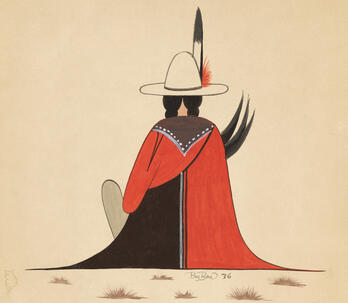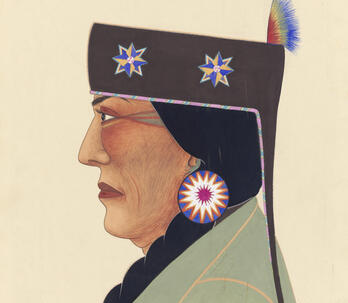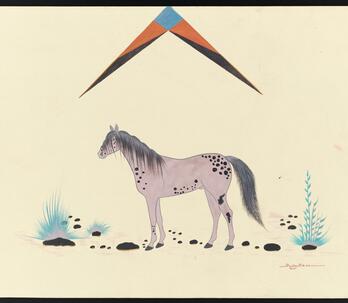Woody Big Bow, January 29, 1915 - July 10, 1988, Native American; Kiowa (Artist)
Woodrow Wilson “Woody” Big Bow was a self-taught artist and an enrolled member of the Kiowa Tribe. The grandson of Kiowa Chief Big Bow, he was born and raised on family land in Carnegie, Oklahoma, part of the Kiowa-Comanche-Apache Reservation. Big Bow is best known for his emotive paintings depicting Indigenous subjects, and for designing the thunderbird insignia that was chosen to represent the 45th Infantry Division (the Thunderbirds) of the U.S. Army.1 He attended the University of Oklahoma, graduating in 1939, and he served in the military in World War II.
Big Bow’s narrative-based Flatstyle2 works capture the vitality and longevity of Kiowa painting traditions, and his subjects include the range of Indigenous life from the sacred to the mundane. His success as an artist can be attributed to his ability to capture his experiences, memories, and worldview through his paintings and drawings. He had a number of patrons, including Thomas Gilcrease, and his works can also be found in the Philbrook Museum of Art (Tulsa), the National Museum of the American Indian (Washington, D.C.), the Oklahoma Historical Society, and the Heard Museum (Phoenix), among others.
The Gilcrease collection has examples of twentieth-century artworks from other members of the family—including his siblings Harding Big Bow (1921–1997), Nelson Big Bow (1917–2010), and Ella Fay Horse (née Big Bow)—as well as several archival photographs of the Big Bow family taken during the late nineteenth century.
“He [Woody Big Bow] was born and raised in Carnegie. My grandparents lived outside of Carnegie. . . . Painting was his life’s work . . . he traveled often and had a studio outside of Taos [Pueblo]. . . . He had his own style, and painted his own world, his own life.” —Vivian Big Bow (Kiowa), November 16, 2021
—Jordan Poorman Cocker, Henry Luce Foundation Curatorial Scholar for Indigenous Painting Collection Research, 2021
This text was developed from an interview with Vivian Big Bow (Kiowa), daughter of Woody Big Bow, by Jordan Poorman Cocker, November 16, 2021
_____________________________
1 Oklahoma’s famed 45th Infantry Division was part of the Oklahoma Army National Guard between 1920 and 1968. The 45th Infantry fought in World War II and the Korean War.
2 The Indigenous art movement known as Flatstyle is also called the Kiowa Style and the Oklahoma Style. Paintings and drawings in this style are characterized by a lack of figural shading, and by backgrounds that have a shallow or indistinguishable depth of field. Flatstyle was developed by Spencer Asah, James Auchiah, Jack Hokeah, Stephen Mopope, Lois Smokey, and Monroe Tsatoke, members of an early twentieth-century Indigenous art collective known as the Kiowa Six (first called the Kiowa Five). The collective was under the tutelage of Professor Oscar Jacobson at the University of Oklahoma.












































